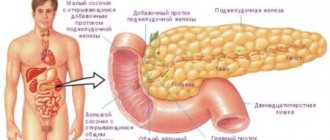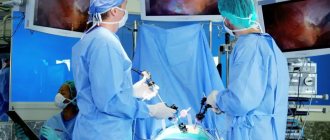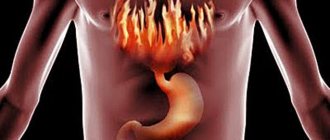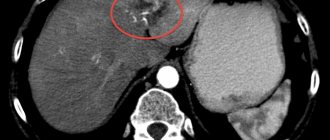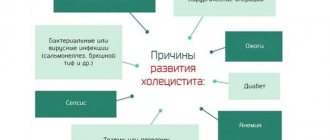Symptoms of pathology and what it means
The clinical picture of splenomegaly is ambiguous, because it depends on what exactly triggered its development. In general, there are such general signs of the inflammatory form of pathology as:
- pain in the left side of the peritoneum;
- heaviness and overcrowding in the stomach area, developing due to the fact that the spleen enlarges and begins to put pressure on the walls of the neighboring organ;
- increase in body temperature;
- intoxication;
- nausea, rarely with productive vomiting.
Pallor of the skin, bruises under the eyes, as well as an increase or occurrence of night sweats, and a sharp and unmotivated decrease in body weight are likely to occur.
The non-inflammatory form is characterized by a rather poor clinical picture. So, the patient is rarely, but still bothered by nagging painful sensations in the left side of the peritoneum. Temperatures may increase, but only to low-grade fever.
At the same time, for example, with pathologies of the genitourinary system, the symptoms are as follows:
- discomfort and painful aching sensations in the left side of the peritoneum;
- overcrowding in the stomach even with the minimum ratio of food consumed;
- constant urge to urinate, severe burning and itching after each productive urge.
Thus, we can say with confidence that the characteristics of the symptoms can be used to judge the form of the disease and the reasons for its development. Given the criticality of the symptoms, it is very important to cure the spleen if it is enlarged, and how exactly to do this will be discussed below.
Symptoms of inflammation of the spleen
Pain syndrome appears when the abdominal cavity is affected. If the inflammation is local, it is determined only by test results
. A common symptom is an enlarged spleen.
The condition is called splenomegaly, and it causes a feeling of fullness in the left hypochondrium and pain in neighboring organs.
Symptoms depend on the cause of the pathology and may include:
- vomiting;
- dry mouth;
- dizziness;
- tachycardia - increased heart rate;
- increased sweating;
- bruises, hemorrhages;
- loss of appetite;
- sleep disturbance;
- chills;
- shortness of breath;
- intense pain that radiates to the shoulder blade, collarbone, and spreads across the abdomen;
- rise in body temperature to 40 degrees – with a purulent abscess;
- weakness, malaise.
Features of symptoms in women
The signs of the inflammatory process are the same in both sexes, but men suffer from it 5 times less often. In women, hormonal levels are constantly changing, and this leads to the appearance of cysts, and due to weak abdominal muscles, the spleen can move around the abdominal cavity. For this reason, pain in the clinical picture occurs more often
. In addition, women experience the following symptoms:
- skin itching;
- weakness, fatigue in the morning;
- allergic rashes;
- ulcerative lesions on the skin and mucous membranes.
Causes of enlarged spleen in adults, why and from what
In general, the reasons for the development of this pathology can be divided into five main groups, including infectious and toxic processes, increased breakdown of blood cells, stagnation of venous blood, its diseases and mixed origin.
In the first case, the reasons for an enlarged spleen in adults are hepatitis, type, sepsis, and an infectious form of endocarditis. The list of chronic infections is supplemented by sarcoidosis, syphilis, and malaria. Splenomegaly can develop, as already noted, with problematic breakdown of blood cells - this can be anemia and some autoimmune diseases (neutropenia and others).
Acute heart failure, Banti's disease, lymphogranulomatosis, lymphoblastic leukemia - all these are no less significant factors in the appearance of pathology. In addition, when answering the question why the spleen is enlarged in an adult, pay attention to:
- amyloidosis;
- Gaucher disease;
- histiocytosis X;
- the presence of cystic formations, for example, parasitic;
- dysfunction of the endocrine gland with subsequent thyrotoxicosis;
- rupture of the organ under the capsule with the occurrence of hemorrhage directly into the thickness of the spleen.
In addition, splenomegaly may well be one of the manifestations of a disease such as systemic lupus erythematosus.
Types of diseases
Primary organ damage is rare, but secondary damage occurs much more often. The most typical pathologies are:
- Developmental anomalies – congenital absence (asplenia) occurs, as well as the presence of two or more organs;
- Splenic infarctions are a relatively common occurrence. Possible development factors are leukemia, infections;
- Inflammatory diseases are the predominant pathognomonic mechanism that accompanies many infections, including viral etiologies, and invasions;
- Abscesses. They are a consequence of heart attacks, infective endocarditis, and typhoid fever.
What to do - treatment of an enlarged spleen
If a person has an enlarged spleen, this means that treatment must be started as soon as possible. This is possible only after determining the exact cause of the pathology. There are such directions in therapy as the use of antibiotics for infectious pathology.
For viral forms of splenomegaly, immunomodulators are prescribed, as well as a whole range of antiviral therapy. If the root cause turns out to be a helminthic infection, we are talking about the use of anticestodiasis, antitrematodiasis names; vitamin-mineral complexes will also be effective.
An important condition is diet therapy, which facilitates the functioning of the digestive system.
If conservative methods are not sufficiently effective, surgical intervention is performed to remove the organ. After such a procedure, there is a possibility of a significant weakening of the immune system, and therefore antibiotics, compounds to improve immunity and antiviral names are prescribed.
Preventive measures can also help treat an enlarged spleen. It is important to exclude nicotine and alcohol addiction, eat exclusively healthy foods, and also promptly treat all gastrointestinal diseases, and undergo regular examinations with a gastroenterologist. This will protect your body from any pathologies that provoke splenomegaly.
Enlarged spleen, or splenomegaly, is a symptom that indicates the development of a certain pathological process in the body, and is not a separate disease. We can talk about organ enlargement when its weight reaches 200 grams or more (normally this is no more than 150 grams). In this case, the spleen can be easily palpated and additional symptoms are necessarily present. Somewhat less frequently, but still there are cases where this organ has enlarged without an accompanying pathological process. Definitely, if you have such a symptom, you should consult a doctor and not self-medicate. Such medical measures can cause serious complications and, if the disease is in an advanced form, death.
Spleen diseases
Possible developmental pathologies, past infectious diseases, tumors, trauma are the main causes of the development of diseases in this organ. Only a specialist can make an accurate diagnosis, and possible diseases are discussed in further information.
Amyloidosis
Symptoms are similar to most gastrointestinal diseases. The patient may feel nausea after eating, heartburn, heaviness in the left side and disturbances in normal bowel movements.
Tumors
Diagnosed quite rarely, we are mainly talking about lymphosarcoma. Primary malignant tumors of the spleen practically do not occur, as does the spread of metastases to this area.
Tuberculosis
The manifestations are very mild; with severe damage to the organ, an increase in size occurs. In this case, painful symptoms appear, the spleen can be easily felt by palpation.
Echinococcosis
A very difficult disease to diagnose. The only symptoms are digestive disorders, mild pain in the hypochondrium, nausea and frequent allergic reactions.
Cyst and polycystic
The reasons for the appearance of cysts in this organ are not fully understood. It is known that serous formations appear more often than others, but epithelial ones are extremely rare. Cysts can also appear due to parasitic infection.
Treatment of the pathology depends on the number, size and location of the cysts; in some cases, complete removal of the organ is required.
Abscess
It is characterized by the absence of any symptoms, but this pathology is often preceded by past infectious diseases, therefore, against the background of general weakness, the patient may simply not recognize other negative manifestations. The condition requires treatment, but often recovery occurs without outside intervention.
Heart attack
A fairly common pathology. The area of damage is usually small; the main causes are leukemia or infection.
With an extensive splenic infarction, acute pain appears in the left side, which can radiate under the scapula or into the lower back.
Inflammation
Splenitis or lienitis often develops asymptomatically. When the inflammatory process spreads to nearby tissues, the temperature may rise, fever and chills may appear.
Enlargement and hypertrophy
An increase in the size of the spleen was given the term “splenomegaly”. This is not a separate ailment, but the body’s reaction to past infectious diseases, cardiovascular diseases, oncology or lymphatic pathologies.
Splenomegaly occurs quite often in diseases of the liver and pancreas. This condition can be eliminated only after treating the underlying disease that caused such a reaction. Hypertrophy is a multiple enlargement of an organ while maintaining basic functions.
Stones
They are quite rare due to the physiological characteristics of the organ. They usually do not cause any inconvenience to the patient and do not require treatment.
If detected, periodic monitoring of the size of the stones is indicated. The main causes are disturbances in the normal metabolism of calcium in the body and endocrine diseases.
Damage
Mechanical impacts, direct impacts and compression of the organ can lead to rupture of the membrane. Treatment for such conditions is often surgical; depending on the size of the damage, restoration of the membrane or complete removal of the spleen is performed.
Aneurysm
Dilatation of the splenic artery occurs in approximately 1% of all cases of aneurysm. Most often it is diagnosed accidentally during a routine examination.
It is a potentially life-threatening pathology and requires mandatory surgical intervention. When an artery ruptures, the mortality rate is almost one hundred percent, so the aneurysm cannot be treated with conventional conservative methods.
Hypoplasia
A congenital pathology in which the organ remains underdeveloped, but at the same time retains its functions. Not being treated usually does not affect the quality of life of patients.
Hemosiderosis
An extremely difficult disease to diagnose and treat. Appears as a result of metabolic disorders in which hemosiderin accumulates in tissue cells - a special pigment that appears during the breakdown of hemoglobin. The disease usually occurs in older men and is extremely difficult to treat.
Vein dilations
It manifests itself as a result of the development of portal hypertension, when the normal structure of the portal vein is disrupted. Severe pathology requiring complex and long-term treatment.
Myeloid metaplasia
The disease is a transformation of one type of tissue into another. The appearance of a similar disease in the spleen often occurs after infections.
Fibrosis
A pathological process in which normal cells of an organ are replaced by connective tissue. This happens under the influence of the inflammatory process, as a result of injuries and bruises.
Sarcoidosis
One of the most unexplored diseases. It is characterized by the formation of small tissue nodules in the affected organ - granulomas. Most often it affects the pulmonary system and usually does not require treatment. It is not transmitted to others and is not infectious.
Necrosis
The death of spleen cells can occur as a result of advanced diseases, circulatory disorders and other pathologies. The prognosis is extremely unfavorable; tissue breakdown can lead to sepsis of the entire body, so the affected organ is removed.
Volvulus
Twisting of the splenic pedicle requires mandatory surgical intervention. Without treatment, this will lead to insufficient blood supply, tissue necrosis and sepsis.
Developmental anomalies
Pathological conditions often include congenital anomalies of organ development. We are talking about “non-standard” sizes, location, and even the presence of two or more spleens.
Quite rare is the complete absence of this organ, as well as free movement, which is called the “wandering spleen.” Most often, this anomaly is diagnosed in women.
The only possible treatment is its removal, because in the future this can lead to rupture of the capsule and the occurrence of life-threatening conditions.
Etiology
An enlarged spleen in a child or adult can be caused by the following factors:
- bacterial or viral infection;
- protozoal infections;
- helminths;
- pathologies of other organs and systems in the body;
- idiopathic in nature.
Bacterial and viral infections that can trigger splenomegaly include the following:
- splenic tuberculosis is one of the most dangerous diseases, since due to the blurred clinical picture it is diagnosed already in the later stages;
- rubella;
- syphilis;
- mononucleosis;
- viral hepatitis;
- brucellosis.
Protozoal infections that can be regarded as causes of an enlarged spleen include the following:
Helminthiases, which are the etiology of an enlarged spleen, include the following:
It should be noted that the first type of disease is practically not found in the CIS countries, while the second is widespread throughout the world.
Common pathological processes that provoke an enlarged spleen include the following:
- cirrhosis of the liver;
- circulatory disorders;
- oncological processes;
- diseases of the genitourinary system and gastrointestinal tract;
- autoimmune pathologies (most often lupus erythematosus and rheumatoid arthritis).
In addition, this symptom can be provoked by systematically poor nutrition, with the abuse of fatty foods, and alcoholism.
Classification of spleen disease
Depending on the pathogenesis and etiology, two forms of the disease are distinguished.
- Non-inflammatory in nature. This form occurs as the body’s response to various diseases - leukemia, liver cirrhosis, thrombosis, amyloidosis, anemia. The clinical picture is blurred, and the symptoms indicate the underlying disease.
- Inflammatory in nature. This form is provoked by viral, bacterial, fungal and protozoal infections. Enlargement of the organ is observed with malaria, salmonellosis, tuberculosis, rubella, and viral hepatitis. And also for mononucleosis, typhoid fever, syphilis and sepsis. The clinical picture is bright, the intoxication is strong.
Symptoms
The overall clinical picture, in this case, is quite ambiguous, since the nature of the symptoms will mainly depend on the underlying factor. However, in general, it is possible to identify signs that are characteristic of a certain form of the pathological process. So, with the inflammatory nature of the enlargement of the spleen, the symptoms may be as follows:
The non-inflammatory form has a rather sparse clinical picture - occasionally the patient may be bothered by nagging pain in the left area of the abdominal cavity, the temperature rarely rises to low-grade fever.
Enlargement of the liver and spleen can be caused by viral hepatitis, which manifests itself in the following symptoms:
- ARVI symptoms;
- headache;
- increased fatigue and weakness, which is caused by intoxication of the body;
- yellowing of the skin;
- disruption of the functioning of the gastrointestinal tract;
- nausea, often with vomiting, vomiting does not bring relief;
- sleep disturbance.
Since this clinical picture is similar to influenza or ARVI, most patients do not seek medical help in a timely manner. Organ enlargement can be diagnosed only in the advanced stages of viral hepatitis.
In case of pathologies of the genitourinary system, the clinical picture can be characterized by the following signs:
- a feeling of discomfort and aching pain in the left region of the abdominal cavity;
- a feeling of fullness in the stomach even with a minimal amount of food consumed;
- frequent urge to urinate, burning and itching after bowel movement;
- Women may experience menstrual irregularities;
- decreased desire for a sexual partner, discomfort during sexual intercourse.
The reason that the spleen is enlarged may be tuberculosis of this organ. However, the clinical picture in this case, until a certain stage of development, has practically no specific signs. In the later stages of the development of this disease, the clinical picture may be supplemented by the following manifestations, which can be determined by laboratory and instrumental methods:
- a sharp decrease in the number of leukocytes, platelets;
- poor blood clotting, which can lead to hemorrhage;
- the organ itself has a densely elastic consistency, with places of softening in the area of caseous decay.
In some cases, splenic tuberculosis is a complication of liver cirrhosis.
Healthy spleen
The spleen is a relatively small organ that is about 11 cm long, 7 cm wide, 4 cm thick and weighs between 150 and 200 g. The spleen is bean-shaped and soft in consistency in both men and women. The color varies between cherry red and blue-violet.
Location of the spleen in the human body
Anatomy and physiology
The spleen is located below the diaphragm in the left upper abdomen: it borders the left kidney and pancreas. With the help of connective tissue it is connected to neighboring organs. On the outside, the spleen is surrounded by a connective tissue capsule that protects it from external influences.
The internal contents of the spleen are called pulp. The pulp is divided into two zones: red and white, they perform different tasks. The spleen is supplied with blood through the splenic artery. Blood flows from it to the liver. Blood is pumped through the spleen about 500 times every day.
- The red pulp consists of venous sinuses, pulp cords and Billrothe. In the pulp, old blood cells are captured and destroyed by macrophages. The spleen converts iron into hemoglobin (the red pigment in the blood). Even small blood clots and “used” platelets are sorted and destroyed in the spleen.
- The white pulp is part of the immune system. Lymphocytes (a certain type of white blood cell) are stored here, which also partially mature in the spleen. About 30% of all leukocytes are stored in the white pulp. Lymphocytes respond to pathogens - bacteria or viruses - that enter the spleen in the blood. When needed, lymphocytes are also released into the blood. In addition, immunoglobulins are formed in the white pulp, which are special antibodies against pathogens.
The spleen always stores a certain amount of blood, which is released, for example, during bleeding or in case of intense physical activity. It is also the site of macrophage production. Monocytes make up to 30% of macrophages, which destroy some bacteria in the spleen.
Normal indicators
Ultrasound determines the shape, position of the organ, size and density of the spleen tissue. Typically, 3 main size indicators are considered: length, width and height. For an adult, 11-12 centimeters in length, 6-8 in width and 4-5 in height are normal. The spleen is normally located approximately in the region of the 9th-11th rib in the left upper quadrant of the abdominal cavity.
Diagnostics
At the initial stage of diagnostic procedures, a physical examination of the patient is carried out with palpation of the organ area and collection of anamnesis. It is imperative to clarify whether the patient was in tropical countries the day before and how he ate. If the patient has taken any medications that are not recorded in the outpatient card, the doctor should be notified.
The diagnostic program may include the following:
- clinical and biochemical blood test;
- general analysis of stool and urine;
- biological markers for the presence of autoimmune pathologies;
- Ultrasound of internal organs;
- CT or MRI;
- sternal puncture.
Consultation with a hematologist is required. In some cases, an examination by an endocrinologist, infectious disease specialist, or rheumatologist may be required.
Prevention
Prevention of this pathology is as follows:
- elimination of bad habits and only nutrition that is healthy for the body;
- timely and correct treatment of all ailments;
- regular examination by specialized medical specialists;
- timely vaccination.
It should be noted that splenomegaly itself rarely leads to serious complications. The underlying disease is life-threatening.
The spleen is an organ that acts as a kind of filter, quickly responding to the ingress of pathogenic bacteria and other equally harmful agents. The spleen is enlarged with intense severity in the area of the left hypochondrium. If you have such a symptom, you should consult a therapist. If splenomegaly is detected during examination, the patient will be prescribed studies to determine the cause of this condition.
The role of the spleen in the body
The organ is located in the upper part of the abdominal cavity under the ribs on the left. The spleen has a slightly elongated oval shape. The main task of this organ is to properly regulate the process of hematopoiesis. At the same time, the blood is filtered from harmful organisms, bacteria and toxins.
This feature makes the system one of the most important centers of the lymph nodes. After purification, pathogenic particles completely disappear, in particular we are talking about dead red blood cells, which can cause cancer. At the slightest attempt to penetrate the body of viruses and infections, the tissues of the spleen will begin to work in an enhanced mode, also sending signals to other parts of the lymphatic system.
Attention! Thanks to the presence of the spleen, it is also possible to regulate the coagulation of blood cells, which protects our vessels from thrombosis and dangerous bleeding. The organ directly responds to changes in other systems, which leads to its rapid increase.
Sizes and functions of the organ
Externally, the spleen resembles a bean, that is, it has an oval, slightly elongated shape. It is located in the abdominal cavity on the left in the hypochondrium. Next to the organ lie: the large intestine, pancreas, left kidney and diaphragm.
The weight of a healthy organ in humans ranges from 150−200 g, width 6−9 cm, and length 11 cm.
The main function of the organ is to control the process of hematopoiesis and coagulation, which protects the body from bleeding and thrombosis. In addition, the spleen filters and purifies the blood from a variety of toxins and infectious agents. Due to this feature, the organ is considered one of the most important accumulations of lymphoid tissue. After cleansing, dead red blood cells and other pathological particles disappear from the blood. If viruses or bacteria enter the body, the work of the spleen tissue is activated, and signals about “pests” are sent to other parts of the lymphoid system.
If there are problems in other systems, the spleen can quickly increase in size (reactive splenomegaly).
Spleen - meaning and functions
The role of the spleen in the human body
The spleen is located in the area of the 9th and 11th ribs vertically in the left side of the abdominal cavity. This organ has an oval flattened shape. The spleen is attached to other organs using special ligaments.
The main function of the spleen is to regulate the hematopoietic system. This lymphoid organ is capable of processing harmful substances and purifying the blood of bacteria and viruses. If a person lacks a spleen for any reason, then his immunity noticeably deteriorates.
The spleen also controls blood cells. Damaged and dead red blood cells are removed and formed elements accumulate in the spleen.
In addition, the spleen performs the following functions:
- Ability to detect foreign antigens and release antibodies
- Dissolving solids from burns or injuries
- Takes part in protein metabolism and the synthesis of albumin and globin
- Participates in the formation of immunoglobulins
The spleen is a special blood filter in which various harmful bacteria and infections settle. The main importance is to protect the body in case of infectious and parasitic diseases.
Causes of splenomegaly
With splenomegaly, the cause in adults lies in a decrease in the organ’s ability to function fully. For example, in the presence of infectious pathologies, the spleen is also damaged due to deterioration in blood composition. Therefore, if the necessary measures are not taken in time, the entire body will suffer.
It should be noted that splenomegaly is often a consequence of tumors or thrombosis of the spleen itself.
In addition, the reason for organ enlargement may be:
- Gaucher disease;
- blood pathologies (including hemolytic anemia);
- rheumatoid arthritis;
- liver diseases (including cirrhosis and portal hypertension);
- blood cancer;
- venous thrombosis;
- long-term course of heart failure;
- infectious pathologies: bacterial endocarditis, malaria, AIDS, leishmaniasis and mononucleosis.
The most common factors include liver cirrhosis and tumors, infections and heart failure. The mechanism of organ enlargement during infections (serum sickness, tuberculosis, viral hepatitis) is as follows: normally, old cells in the spleen disintegrate, however, in diseases of infectious origin, the mass of “spent” cells increases significantly and, accordingly, the mass of the organ also increases. In addition, the spleen has a powerful venous network and if blood outflow is disrupted, stagnation forms and splenomegaly develops.
Spleen. We treat, clean, protect (I. A. Kapustina, 2010)
Treatment with medicinal plants
In most cases, traditional medicine does not distinguish between specific diseases of the spleen; recipes rarely contain the instruction: “use for inflammation of the spleen” or “treat tumors of the spleen.” The remedies that our ancestors have long used have a more general purpose: they improve the function of the organ, increase blood flow to it, which gives a healing effect. This approach must be recognized as very logical, especially if you consider that only a specialist with modern equipment can distinguish between ailments. So, if the prescription does not specifically indicate a particular disease, the remedy can be taken for all diseases of the spleen.
And one more recommendation: if the terms of use of the product are not specifically specified, use it for a month, after which they switch to another composition. The fact is that our body gradually gets used to any medicine, including herbal ones, so for long-term treatment different drugs are used.
* * *
Take 1 teaspoon of spleen herb, 1 glass of water.
Pour boiling water over the herb, leave for 2 hours, strain.
Take 1 tbsp infusion. spoon 3 times a day before meals.
For diseases of the spleen, accompanied by pain in the left hypochondrium, make lotions and compresses with the infusion.
* * *
“Several years ago I had inflammation of the spleen. I was in the hospital, took a lot of pills, and it ruined my stomach. When I was discharged, the doctors said that now I would need to undergo maintenance treatment twice a year, otherwise the disease would return. But I really didn’t want to drink all this “chemistry” again! Quite by accident, I read a prescription in the newspaper for the treatment of the spleen. I decided to try it, fortunately I have plenty of calendula at my dacha, and yarrow grows nearby, in a forest at the edge. I drank an infusion of fresh herbs throughout July and lived peacefully until the next summer - there were no exacerbations. The next year I repeated the treatment and took some dried herbs with me just in case. If any of my friends have pain in their left side, I immediately give them herbs so they can drink the infusion. It helps everyone, but I haven’t thought about my illness since then!”
Meshcherskaya Tatyana Borisovna
Take 1 tbsp. spoon of yarrow herb with flowers, 1 tbsp. a spoonful of calendula herb (whole plant), 2 glasses of water.
Grind the plant materials and mix. Pour boiling water over the collection and leave until the liquid cools completely, then strain.
Take according to 1/3
a glass of infusion 2 times a day, regardless of food intake, for inflammation of the spleen for 3 weeks.
The product can be used prophylactically if taken according to 1/4
glasses 2 times a day for 2 weeks 2 times a year - in spring and autumn.
* * *
Take 1 tbsp. spoon of chicory root, 1 glass of water.
Grind the root, pour into a thermos and pour boiling water over it. Leave for at least 40 minutes, strain.
Take 2 tbsp. spoons of infusion 3 times a day, regardless of meals, for an enlarged spleen.
* * *
Take 1 teaspoon of chicory extract, sold in pharmacies, 0.6 liters of water, 3 teaspoons of honey.
Dilute the extract with boiling water, add honey to it, stir.
Drink 1 glass of hot liquid 3 times a day instead of tea.
* * *
Take 3 tbsp. spoons of chicory root, 1 liter of quality vodka.
Grind the root, pour into a dark glass bottle, add vodka and leave in a warm place for 3 weeks, shaking the bottle 2-3 times a week. Strain the finished tincture, squeezing out the plant material.
For pain in the spleen, take 25 drops of tincture with water, 1 time per day - in the morning, before breakfast.
* * *
Take 100–200 g of fresh chicory leaves.
Wash the leaves, chop into pieces, pour boiling water so that it lightly covers the plant material. After 5 minutes, drain the boiling water and lightly squeeze the leaves.
Place the poultice on the left hypochondrium for 10–15 minutes. Use the product for inflammation of the spleen once a day for 25 days.
* * *
Take 2 teaspoons of hop cones, 1 glass of water.
Grind the cones, pour boiling water, leave for 25 minutes, then strain.
Apply 2 tbsp. spoons 4 times a day after meals. From the remaining plant material you can make a poultice, as described in the previous recipe.
The drug is used for enlarged spleen.
* * *
Take 1 teaspoon of silver wormwood, 2 glasses of water, 1 tbsp. spoon of honey.
Pour boiling water over the wormwood, leave in a water bath for 15 minutes, cover with a lid, then strain and mix with honey.
Take according to 1/4
glasses 3 times a day 40 minutes before meals.
* * *
Take 100–200 g of wild ivy (whole plant).
Grind the ivy into a pulp, squeeze out a little juice.
Apply the plant pulp to the left hypochondrium for 15 minutes. The course of treatment is 2 weeks. After a month, the course can be repeated.
* * *
Take 1 tbsp. spoon of soapwort root, 1 teaspoon of willow bark, 3 glasses of water.
Grind the roots, add cold water and leave for 3-4 hours. Then boil in a water bath for 15 minutes, then pour the broth into a thermos and leave for 1 hour. Strain.
Take according to 1/2
glasses of decoction 3 times a day, regardless of meals.
* * *
Take 1 teaspoon of nettle leaves, 1 teaspoon of plantain leaves, 1 tbsp. spoon of sage herb along with flowers.
Dry the plant materials, chop and mix. Store in a cool, dry place, preferably in a wooden box.
Take according to 1/4
teaspoon of the mixture, without drinking anything, 3 times a day before meals for spleen tumors. The course of treatment is 1 month, after a 2-month break the course can be repeated.
* * *
Take 1 tbsp. spoon of the whole nettle plant, string grass, tricolor violet flowers, strawberry leaves, 3 cups of water.
Grind the plant materials and mix. 2 tbsp. Pour spoons of the mixture into a thermos, pour boiling water over it and leave for 1 hour, then strain.
Take 1 glass 3 times a day after meals.
* * *
Take 1 teaspoon of celandine herb, 2 glasses of water.
Grind the herb, pour boiling water, leave for 20–25 minutes, strain.
Take according to 1/2
a glass of infusion 3 times a day 40 minutes before meals for an enlarged spleen and liver.
* * *
Take 1/2
cups of dried figs, 1 cup of 3% vinegar, 1 cup of dry red wine.
Soak the fruits in vinegar for 3 hours. Drain the vinegar and pour red wine over the figs. Leave for 3 hours. Pour the wine into a separate container and pass the fruit through a meat grinder.
For pain in the spleen, drink 1 glass of wine infusion and make a poultice of chopped figs on the left hypochondrium.
* * *
Take 1 tbsp. a spoonful of chaga, 5 glasses of water.
Pour hot water over the mushroom for 3-4 hours, then chop (grate or mince). Pour the prepared raw materials with hot (5 °C), but not boiling water and leave for 2 days in a cool, dark place. Strain.
Take 1 glass of infusion 2-3 times a day, regardless of meals. The course of treatment is 3 weeks. During treatment, it is advisable to adhere to a vegetarian diet. After six months, the course can be repeated.
The remedy helps not only with enlargement and inflammation of the spleen, but also with its tumor.
* * *
Take 2 tbsp. spoons of agrimony herb, 1 glass of water.
Grind the herb, pour boiling water, leave for 20–30 minutes, then strain.
Take according to 1/2
a glass of the product 2 times a day after meals. If desired, you can add 1 teaspoon of honey to the infusion.
* * *
Take 1 cup of fresh hemp seeds, 4 cups of milk.
Pass the seed through a meat grinder, pour in milk and simmer in the oven until 1 cup of liquid remains. Strain.
If the spleen is enlarged, drink the prepared decoction in the morning on an empty stomach. Do not have breakfast on this day. The course of treatment is 7 days. After 10 days the course can be repeated. In the first 2 days of treatment, pain may increase.
* * *
Take 2 tbsp. spoons of creeping wheatgrass root, 2 cups of water.
Grind the root, add cold water, leave for 3 hours, then boil over low heat for 10 minutes, strain.
Take according to 1/4
glasses of decoction 4 times a day before meals.
* * *
Take 1 tbsp. spoon of lovage roots, 2 cups of water.
Grind the roots, add boiling water and cook in a water bath for 15 minutes. Then leave the broth, wrapped, for 1 hour. Strain.
Take according to 1/4
a glass of decoction 3 times a day 10 minutes before meals.
* * *
Take 1 tbsp. a spoonful of white mari grass, 1 glass of water.
Pour boiling water over the herb, leave, covered, for 10 minutes, then strain and cool.
Take 1 tbsp. spoon 5 times a day, regardless of food intake, for inflammation of the spleen.
* * *
Take 3 tbsp. spoons of common pikulnik herb, 2 glasses of water.
Pour cold water over the herb and bring to a boil over low heat, but do not boil. Leave for 30 minutes, strain.
Drink the entire infusion in small sips throughout the day.
* * *
Take 1 tbsp. a spoonful of common millipede roots, 2 cups of water.
Grind the roots, pour into a thermos, pour boiling water and leave for 3-4 hours. Strain.
Take according to 1/4
glasses 4 times a day after meals.
* * *
Take 1 tbsp. a spoonful of iris root, 1 glass of water.
Grind the roots, pour boiling water, leave for 2 hours. Strain.
Take 2 tbsp infusion. spoons 3 times a day, regardless of meals.
* * *
Take 1 tbsp. a spoonful of common budra herb, 1 glass of water.
Pour boiling water over the herb, leave for 15 minutes, strain.
Take according to 1/3
glasses of infusion 3 times a day before meals.
* * *
Take 200 g of willow leaves, 1 glass of table vinegar.
Dilute the vinegar by half with warm water, pour it over the crushed willow leaves. After 15 minutes, drain the vinegar and lightly squeeze the plant material.
Apply the paste of leaves to the place of greatest pain in the left hypochondrium, cover with cellophane film, and wrap with a warm scarf. Secure the compress with a bandage. Keep the compress for 30 minutes. The course of treatment is 10 procedures. After a month's break, the course can be repeated. The product helps with inflammation of the spleen.
* * *
Take 1 teaspoon of madder roots, 2 cups of water.
Grind the roots, add boiling water and cook in a water bath for 10 minutes with water boiling strongly. Strain.
For inflammation of the spleen, take a decoction according to 1/2
glasses 2 times a day before meals.
* * *
Take 1 teaspoon of shepherd's purse herb, 1 glass of water.
Grind the herb, pour into a thermos, pour boiling water and leave for 2 hours. Strain.
For spleen tumors, take 1 glass 2 times a day - in the morning on an empty stomach and in the evening before bed.
* * *
Take 1 tbsp. a spoonful of fresh dandelion flowers, 1 glass of water.
Pour boiling water over the flowers, leave for 30 minutes, strain, lightly squeezing the plant material.
For spleen tumors, drink the entire prepared warm infusion in small sips before going to bed.
In winter, dry dandelion root can be used instead of flowers.
* * *
Take 1 teaspoon of dandelion roots, 1 glass of water.
Grind the roots, add boiling water and cook over low heat for 20 minutes, strain.
For spleen tumors, drink the entire prepared hot broth in small sips before going to bed.
* * *
Take 100 g of dry cucumber seeds and grind into powder.
Take according to 1/2
teaspoon in the morning on an empty stomach for tumors and cysts of the spleen.
* * *
Take 1 glass of fresh hop cones, 1 liter of quality vodka.
Pour vodka over whole cones and leave in a cool, dark place for three weeks, shaking occasionally. Then strain.
Take 40 drops of tincture with water 3 times a day, regardless of meals, for inflammation of the spleen.
* * *
Take 1 tbsp. spoon of small centaury herb, 1 glass of water.
Pour boiling water over the chopped herb, leave for 10 minutes, strain.
Take according to 1/2
a glass of infusion 3 times a day 30 minutes before meals for an enlarged spleen.
* * *
Take 1/2
teaspoon of goat hoof ash, 1 teaspoon of 3% vinegar, 1 teaspoon of honey, 1 glass of water.
Dissolve honey in warm water and cool. Add vinegar and ash, stir thoroughly.
Drink the prepared product in the morning on an empty stomach. The course of treatment is 2 weeks. After six months, treatment can be repeated.
The remedy is used for tumors and enlargement of the spleen.
* * *
Take 1 tbsp. spoon of verbena herb (with flowers), 1 glass of water.
Pour boiling water over the herb, leave, covered, for 40 minutes. Strain.
Drink the prepared infusion in small sips throughout the day.
* * *
Take 2 tbsp. spoons of tripartite herb, 2 glasses of water.
Pour the crushed herb into a thermos, add boiling water and leave for 12 hours.
Take according to 1/2
glasses 4 times a day, regardless of meals.
* * *
Take 1 tbsp. a spoonful of soapwort roots, 2 cups of water.
Pour boiling water over the crushed root and leave, covered, for 2 hours. Strain.
Take 2/3 cup 3 times a day, regardless of meals, for inflammation and enlargement of the spleen.
* * *
Take 2 tbsp. spoons of burnet roots, 1 glass of water.
Grind the dry roots into powder, add cold water and leave for 8 hours. Strain.
Take 1 tbsp. spoon 4 times a day, regardless of food intake, for inflammation and enlargement of the spleen.
* * *
Take 2 tbsp. spoons of bindweed herb, 1 glass of 3% vinegar.
Pour vinegar over the herb and leave for 24 hours. Strain.
Dissolve 1 teaspoon of infusion in 1/2
glasses of water. Take the remedy for inflammation of the spleen 2 times a day: in the morning on an empty stomach and in the evening before bed.
* * *
Take 1 teaspoon of small periwinkle herb, 1 glass of water.
Pour boiling water over the herb, leave for 20 minutes, strain.
Take according to 1/3
glasses 3 times a day, regardless of meals.
* * *
Take 1 tbsp. spoon of pine buds, 1 glass of water.
Chop the buds, pour boiling water over them and leave for 20 minutes, then place in a water bath and boil for 7-10 minutes. Strain.
For pain in the spleen, drink a glass of warm broth in one gulp.
* * *
Take 1 tbsp. spoon of rosehip roots, 1 tbsp. a spoonful of dandelion roots, 2 tbsp. spoons of sorrel leaves, 3 glasses of water.
Grind the roots. Pour the rose hips into a thermos, pour 1 cup of boiling water and leave for 2 hours, strain. Pour 1 cup of boiling water over dandelion and leave for 4 hours, strain. Pour the remaining boiling water over the sorrel and leave for 30 minutes, strain.
In the morning before meals, drink the entire rosehip infusion, after lunch - dandelion infusion, in the evening before bed - sorrel infusion. The course of treatment is 2 months. After 3 months the course can be repeated.
The remedy is used for inflammation and enlargement of the spleen.
* * *
Take 1 large Kalanchoe leaf and carefully scrape the skin from the upper surface of the leaf with a sharp knife.
Apply the sheet to the left hypochondrium for 30 minutes.
* * *
Take 1 tbsp. a spoonful of wild strawberry leaves and berries, 3 glasses of water.
Pour the plant material into a thermos and pour boiling water over it. Leave for 2 hours. You don't have to strain it.
Drink the infusion instead of tea 3 times a day, regardless of meals.
* * *
Take 1 tbsp. a spoonful of ferula root, 2 glasses of high-quality vodka.
Grind the roots, add vodka and leave in a warm, dark place for 1 month, shaking occasionally. Strain.
Take 20 drops of tincture, diluted with water, 2 times a day, regardless of meals.
* * *
“My mother cured me of tuberculosis. I won’t hide it – I was sitting there and contracted the disease. He coughed very badly and his chest hurt. He was treated in a dispensary. The lungs seem to have healed. But still no strength. Like some kind of disabled person: now the temperature rises, now he gets sick here, now there. Then my left side began to ache. I decided that there was something wrong with my heart and went to the clinic. They did an ECG and took tests. They said that everything was fine with the heart, but we had to go to the dispensary again. We are strict about this at work, we had to go. I was again admitted to the hospital and began to be examined. They quickly found out that I had a rare disease - splenic tuberculosis. They began to treat. I couldn't stand it for long - I ran away. I decided: I don’t care about work and health, I can’t sit locked up anymore.
My mother cried and ran to her friends to find out how they could help me. I don’t know who recommended this remedy to her. She gave me the infusion for almost a year. Gradually I began to feel better, the fever went away completely, I gained strength, and my mood became better. I recently got a job again. They ordered me to undergo a medical examination. After the tests they said I was healthy.”
Kolychev Dmitry
* * *
Take 2 tbsp. spoons of nettle leaves, 2 tbsp. spoons of rose hips, 1 tbsp. a spoonful of knotweed herb, 1 teaspoon of blue cyanosis root, 1 teaspoon of golden cyanosis herb, 1 liter of water.
Grind the roots and fruits, mix the plant materials. 3 tbsp. Pour spoons of the mixture into a thermos and pour boiling water, leave for 3–5 hours, strain.
Take 1 glass of infusion 3 times a day 20 minutes before meals. The course of treatment is 3 years with breaks of 10 days every 2 months.
The drug is used for tuberculosis of the spleen.
Clinical picture
Manifestations of the disease become intense due to the inability of the organ to adequately cleanse the blood. The spleen seizes blood cells to eliminate the developing infection. However, this process negatively affects the operation of the system.
The large mass of pathogenic cells absorbed by the organ significantly reduces the filtration capabilities of the tissues, which is why the spleen grows even more. As a result, the development of hypersplenism syndrome is possible, characterized by the non-stop absorption of blood cells by the spleen and, as a result, destruction of the body.
The number of formed elements in the blood (platelets, leukocytes and erythrocytes) sharply decreases. In this case, in addition to splenomegaly, anemia, frequent nosebleeds occur, women complain of abnormally long and extremely heavy periods. At the same time, various infectious diseases develop, including the common cold, but they are extremely difficult to treat. The smallest scratches take a long time to heal, and the blood clots extremely slowly.
At the same time, the spleen begins to absorb not only “waste” or pathological cells, but also healthy functioning elements necessary for the body.
Video
The spleen is an unpaired organ of the lymphatic system in the abdominal cavity, located behind the stomach. Does not apply to vital structures
.
Functions: hematopoietic, immune, filtration. In the prenatal stage, it is the main hematopoietic organ
.
Diagnosis of spleen diseases is difficult. There are no pain receptors in the organ, so pain occurs when the capsule surrounding the pulp is stretched or damaged due to changes in structure and pressure on surrounding tissues
. If unpleasant symptoms appear in the left hypochondrium, you should consult a doctor. If the changes become irreversible, the organ will have to be removed.
Classification of the disease
It is worth noting that any changes in the organ do not cause pain. However, its increase can cause discomfort, and pain is a consequence of compression of neighboring organs by the “grown” spleen. Enlarged spleen is divided into several types and degrees.
Splenomegaly occurs:
- primary (if the reason for the enlargement of the organ lies in diseases of the spleen itself). For example, for abscesses, hemangiomas, splenomas, and so on;
- secondary (splenomegaly is the result of pathologies in other organs).
The disease is also divided into degrees. It is from them that the doctor can find out how serious the disease is:
- 1st degree. The spleen stands out from under the arch of the ribs by 1 cm. Upon palpation, its lower belt is revealed;
- 2nd degree. The organ is located between the ribs and the navel;
- 3rd degree. The organ is palpated along the midline;
- 4th degree. The spleen can be identified in the pelvis or in the right area of the abdomen.
Symptoms of spleen disease in humans
It is not known for certain, but it is very likely that the spleen is directly involved in filtering the blood and maintaining the balance of metabolic processes in the body. This same organ ensures normal blood clotting.
There are quite a lot of diseases that can affect the spleen. The first signs of spleen disease may differ.
Splenic infarction
Such a disease causes blockage of the blood vessels that supply the organ, causing its functions to be impaired. The patient feels discomfort in the right hypochondrium and abdomen. Very often a heart attack is accompanied by:
- severe nausea;
- vomiting that does not bring the slightest relief;
- fever;
- chills.
Injuries, infectious diseases and inflammations
All these factors can cause the formation of an abscess. The symptoms of this spleen disease are similar to those of a heart attack:
- heat;
- fever;
- chills;
- painful sensations.
The pain is acute, intensifying during movement and changing body position.
Tuberculosis
The spleen is susceptible to infection with Koch's bacillus. It is quite difficult to suspect organ tuberculosis - it does not have pronounced symptoms. One of the most obvious manifestations is a high temperature that does not subside over a long period of time.
Benign tumor
Cysts often form in the organ. Symptoms of this spleen disease in both women and men do not appear immediately - only when the tumor increases significantly in size. Due to the enlarged cyst, the size of the organ increases.
Parasitic lesion
The spleen also enlarges during leishmaniasis, a parasitic disease that, fortunately, is rare. With leishmaniasis, the patient feels weak and suffers from high fever. During illness, minor bruises and bruises occur on the body. The disease also causes enlargement of the lymph nodes and liver.
Blood pathologies
Blood diseases have a negative effect on the spleen. Werlhoff syndrome is a prime example. The main symptom of spleen disease in women and men in this case is a change in blood composition. Due to the disease, patients feel weak, suffer from dizziness, and bleeding of mucous membranes.
It wouldn’t hurt to get checked by a specialist for those who are constantly affected by infectious diseases. You should suspect a problem and go for an examination if there is a decrease in hemoglobin, bruises appear on the body even with minor injuries, and regular bleeding.
Diagnostic measures
In order to diagnose splenomegaly, the doctor collects complaints and carefully listens to the medical history and life history. Then he moves on to inspection, percussion and palpation. In addition, to determine the cause of organ enlargement, if any, the following diagnostic measures are carried out:
- CBC (determining the number of blood cells, etc.);
- Used blood (probable changes indicating problems of the pancreas and liver, the presence of anemia);
- OAM (control of the functioning of the urinary system);
- coprogram (assessment of the functioning of the digestive tract);
- stool examination to detect protozoa and worms;
- blood culture;
- Ultrasound;
- sternal puncture;
- CT;
- biochemical markers.
An enlarged spleen, the causes and treatment of which can be determined through research, is not an independent nosology, but a symptom of various diseases.
Treatment of pathology
If the spleen is enlarged, the causes and treatment are inextricably linked. That is, all therapy is aimed at eliminating the underlying disease that caused splenomegaly. For example, when fighting an infection, specific antibacterial drugs will be needed, in the case of oncology - chemotherapy drugs, and so on.
In the presence of autoimmune pathologies, only symptomatic treatment is carried out, since these diseases cannot be cured.
For GOSH pathology, thalassemia, and thromboctopenic purpura, splenectomy is performed (that is, removal of the spleen). Due to the fact that after surgery the patient becomes overly susceptible to pathogenic agents, he must be vaccinated against meningococci, pneumococci and Haemophilus influenzae.
To eliminate splenomegaly, consultations with an oncologist, gastroenterologist, surgeon, hematologist and therapist are necessary. After which the necessary studies will be prescribed, the cause of the disease will be determined and appropriate therapy will be prescribed.
Patients are often interested in how to treat the spleen at home. In addition to traditional methods, folk recipes are also used to treat splenomegaly. Thus, among the most effective folk remedies that can reduce the size of the organ: propolis (alcohol solution), a collection of wormwood, calendula and yarrow herbs, as well as an ointment with ghee, honey and ginger.
Treatment
If a heart attack or rupture of the spleen occurs, it is necessary to stabilize the patient's condition by administering fluids and medications through a vein. A blood transfusion may also be required depending on test results.
There are 4 degrees of splenic rupture:
- Local rupture of the capsule or bruise under it.
- Rupture of the capsule and tissues (except for large vessels).
- Deep fissures that also affect the large vessels of the spleen.
- Complete rupture of the spleen.
After the initial examination, a decision must be made about the need for emergency surgery. The more severe the injury, the sooner surgery is required. Even if the doctor suspects hemorrhage in the abdomen and the circulation is unstable, emergency surgery is performed. The correct and quick choice of methods for treating spleen diseases is an important step.
For autoimmune and other diseases, treatment will depend on the underlying cause. The use of immunosuppressants, hematopoietic drugs or minimally invasive interventions may be required.
Conservative treatment
If surgery is not required, the patient must remain in the hospital, including in the intensive care unit. Especially in the first 24 hours after entering the department, strict bed rest must be observed. Circulatory parameters (such as blood pressure and heart rate) are monitored using a monitor. In addition, careful blood tests and ultrasound examinations should be performed, depending on the severity of the injury. In many cases, the risk of serious complications is significantly reduced after 72 hours.
The treatment regimen depends on the type of disease, therapy is carried out in a hospital setting
Operation
There are many different surgical techniques for splenic rupture. The most radical measure is to remove the entire organ (splenectomy). The condition without a spleen is called asplenia. Splenectomy is currently performed exclusively for severe bleeding in the abdominal cavity and other signs of spleen disease.
In other cases, only part of the organ can be removed (resection) or vascular occlusion in the affected area can be targeted. The latter is performed using suture, glue, electrical or other hemostatic method (for example, thermal coagulation). After this, the patient must stay in the hospital for about 10 days.
It is now also possible to occlude individual vessels of the spleen with a catheter inserted into the inguinal veins (embolization) to stop bleeding. Regular follow-up examinations are decisive for the postoperative course. Some patients may experience abdominal pain for several weeks after surgery. Although the spleen is not a vital organ, complete removal carries certain risks. Because the spleen helps in protecting the body from pathogens, people who undergo splenectomy are at increased risk of developing infectious diseases.
Any abdominal surgery carries common risks. In addition to injury to other abdominal organs, bleeding, infection, allergic reactions, pancreatitis, and portal vein thrombosis may occur. Other possible complications include pseudocysts, abscesses, and arteriovenous shunts (abnormal connections between an artery and a vein).
Living without a spleen is associated with an increased risk of developing infectious diseases. For this reason, people should be vaccinated regularly (especially against pneumococci, meningococci and Haemophilus influenzae). In case of fever, patients should consult a doctor quickly. Long-term antibiotic prophylaxis against bacterial infections should be used only in children.
Some patients may experience postsplenectomy syndrome, which leads to serious blood poisoning. Toddlers and children without a spleen, especially, are at greater risk of developing a severe infection. This form of sepsis usually occurs in the first years after splenectomy. The main causes of systemic infection are pneumococci, meningococci, staphylococci, and strains of Escherichia coli.
In the first 3 months after removal of the spleen, the platelet count increases to critical values. Therefore, treatment with acetylsalicylic acid (as well as heparin) is recommended to reduce the risk of thrombosis due to a large number of platelets.
If pain occurs in the upper quadrant of the abdomen or left shoulder, it is recommended to immediately seek medical help.
Complications and prognosis
In some cases, even if you take prescribed medications carefully, complications may occur. They manifest themselves in the form of leukopenia, anemia or splenic rupture. At the same time, making predictions for recovery is not so easy. Leukopenia is a fairly common occurrence. The process is characterized by a sharp decrease in lymphocytes and leukocytes in the blood. In order to prevent illness, you should make changes to your daily menu by adding protein foods and foods containing vitamins C and B9. In addition, with the permission of a doctor, you can take vitamin complexes in tablets.
Patients suffering from splenomegaly should remember that self-medication can lead to dire consequences. That is why therapy, as well as diagnosis, should be entrusted to specialists.
